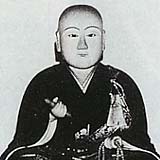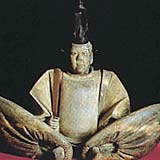History of
Kamakura (2)
Hojo Era
Masako Hojo, the widow of Yoritomo and the mother of two late Shogun, turned hereafter most influential political figure wielding her power, and she was called the Nun Shogun. (Although she had four children including two daughters, she had lost all of her immediate family when she died in 1225 at the age of 68.) The important task then was who should be chosen to be the Fourth Shogun.

As the best alternative, the Hojos invited and appointed Kyoto aristocrat Yoritsune Kujo {yoh-re-tsu-neh koo-joe} (1218-1256), a child with whom Yoritomo had a distant kinship. Believe it or not, he was only a one-year-old baby when he came down to Kamakura, too young to be the Shogun. The Hojos employed the regency system here with real power leaving in the hands of regents and choosing them among its family members. The First Regent was Tokimasa {toh-key-mah-sah} Hojo (1138-1215), Masako's father, and second regency passed to Yoshitoki {yoh-she-toh-key} Hojo (1163-1224), Masako's bother, and from then onward, the regency was handed down to the legitimate sons of the Hojo family one after another until the last 16th Regent. During the Hojo regime which lasted for nearly 110 years from 1219 to 1333, the ruling power continued to rest on them. To keep the Shogun only titular, young children from the aristocrats in Kyoto had always been named. As they grew up, the Hojos replaced them with another child, citing one reason or another. The post of the Shogun was succeeded in the following order:
| Shoguns Term of office (year) | ||||
| Shogun | Birth/Death | In office | Term(yr) | |
| 1st | Yoritomo Minamoto | 1147-1199 | 1192-1199 | 7 |
| 2nd | Yoriie Minamoto | 1182-1204 | 1199-1203 | 4 |
| 3rd | Sanetomo Minamoto | 1192-1219 | 1203-1219 | 6 |
| 4th | Yoritsune Kujo | 1218-1256 | 1219-1244 | 25 |
| 5th | Yoritsugu Kujo | 1239-1256 | 1244-1252 | 8 |
| 6th | Prince Munetaka | 1242-1274 | 1252-1266 | 14 |
| 7th | Prince Koreyasu | 1264-1326 | 1266-1289 | 23 |
| 8th | Prince Hisaaki | 1276-1328 | 1289-1308 | 19 |
| 9th | Prince Morikuni | 1301-1333 | 1308-1333 | 25 |
In Kyoto, Retired Emperor Gotoba {goh-toh-bah} (1180-1239), who had been running the Court just like regents of Kamakura since the incumbent emperor (his son) was too young, thought that the death of Sanetomo might invite a good chance to overthrow the Kamakura Shogunate. He recruited samurai who were not happy with the Hojo regime, and raised an army against Kamakura in 1221. Gotoba's troops were, however, not as strong as he had expected. Third Regent Yasutoki {yah-soo-toh-key} Hojo (1183-1242), son of Yoshitoki, attacked Kyoto right away and Retired Emperor Gotoba was forced to surrender. He was exiled to a tiny island off the coast of Shimane Prefecture. (More than 2,000 political prisoners were detained in this island during 724 to 1867). At the same time, the Kamakura Shogunate established a military station called Rokuhara Tandai {rok-hah-rah tan-dye} in Kyoto in a move to check the Imperial Court, and Yasutoki Hojo assumed the chief commander's position. Since then, top members of the Hojos succeeded to the chief commander of Rokuhara.
The Hojos gained power gradually through a series of winning battles with local warrior factions that once used to be Yoritomo's loyal followers. Growing up from a lord of a small manor in the Izu Peninsula, the Hojos became the most dominant family in 1285 after defeating the last rebel Adachi {ah-dah-che} faction, and established full-fledged feudalism in Japan's medieval ages.

In 1268, Japan had to face an external pressure it had never experienced before. Few knew it might change the fate of the Hojos and the Kamakura Shogunate. Kublai Khan (1215-1294) of Mongol, grandson of Chinggis Khan (1167-1227), sent an envoy to Japan to make the Shogunate acknowledge Khan's suzerainty. The Kamakura Shogunate refused. Mongolia repeatedly sent envoys thereafter, each time urging the Shogunate accept their proposal but to no avail. In 1274, Mongolian armada with 900 ships and 33,000-strong troops invaded northern part of Kyushu island. Fortunately, a typhoon hit the area in the middle of the battle and most of the ships were destroyed, forcing them to retreat. Khubilai sent another envoy in 1279. At the time, Tokimune {toe-key-moo-neh} Hojo (1251-1284) was the Eighth Regent. Not only did he decline the offer, but executed (beheaded) the five Mongolian emissaries after summoning them to Kamakura. Getting infuriated, Khubilai made another attack on Fukuoka Prefecture in 1281 reinforcing the troops to 140,000 soldiers with 4,000 ships. The Japanese warriors were no match for Mongolians and the Khubilai troops invaded up to Dazaifu {dah-zye-foo}, 15 kilometers south of Fukuoka city. By sheer luck, another typhoon struck the area again and it gave a crushing blow to the Mongolian troops. (Hence the Japanese called the typhoon Kamikaze or Divine Winds and many believed even in the Pacific War that Japan would win by the mercy of Kamikaze.)
Peace was restored, but the Japanese warlords who fought against the invaders were not happy since they were not given proper rewards. In the former domestic battles, the Shogunate had granted part of the territories obtained from the enemies as rewards to each warlord of the allies in recognition of their service rendered. In the case of the battle against the Mongolian armada, the Kamakura Shogunate had nothing to grant, even though they won the battle. The warlords were disappointed. The battle also caused financial drain for the Kamakura government. Disputes grew inside the government and the Hojos regime began to skid downward.
Up in Kyoto, Emperor Godaigo {goh-dye-goh} (1288-1339) was looking for an opportunity to overturn the Hojo regime wishing to reinstitute direct Imperial rule, and attempted a revolt in 1324. This attempt was leaked out to Kamakura and the Emperor was sent to the same island as Gotoba had been to. While he was on exile, anti-Kamakura sentiment among the warlords had been nursed to the extent that it was no longer controllable. Commotion were seen throughout the country. One of the loyalist warlords dared to help Emperor Godaigo out of the island in 1333 and insurgence grew imminent. The Kamakura Shogunate orderedits troops to attack Kyoto again with more than 200,000 warriors. The military commander was Takauji Ashikaga {tah-kah-woo-gee ah-she-kah-gah} (1305-1358), who had close blood-relation with the Hojos and was their faithful retainer. In Kyoto, however, he suddenly defected to the Imperial Court betraying the Hojos, and attacked Rokuhara under the Imperial order. In the meantime, Yoshisada Nitta {yoh-she-sah-dah nit-tah} (1302-1338), another warlord in present Tochigi Prefecture, who also had a strong antipathy against the Hojos, formed loyalist forces and assaulted Kamakura at the command of Emperor Godaigo. After waging a fierce battle, they finally succeeded in toppling the Kamakura Shogunate and the Hojo regime, bringing about the end of the Kamakura Period. The battle took a bitter toll and 870-odd samurai of the Hojos committed mass suicide near Hokaiji, including the 14th, 15th and 16th Regents.
The following is the list of the Hojo regents and their term in office:
| Name | Born-dead | In office | Term | Reference | |
| 1st | Tokimasa | 1138-1215 | 1203-1205 | 2yrs | Masako's father |
| 2nd | Yoshitoki | 1163-1224 | 1205-1224 | 19 | Son of Tokimasa |
| 3rd | Yasutoki | 1183-1242 | 1224-1242 | 37 | Son of Yoshitoki |
| 4th | Tsunetoki | 1224-1246 | 1242-1246 | 4 | Grandson of Yasutoki |
| 5th | Tokiyori | 1227-1263 | 1246-1256 | 10 | Grandson of Yasutoki |
| 6th | Nagatoki | 1230-1264 | 1256-1264 | 8 | Grandson of Yoshitoki |
| 7th | Masamura | 1205-1273 | 1264-1268 | 4 | 4th son of Yoshitoki |
| 8th | Tokimune | 1251-1284 | 1268-1284 | 16 | Son of Tokiyori |
| 9th | Sadatoki | 1271-1311 | 1284-1301 | 17 | Son of Tokimune |
| 10th | Morotoki | 1275-1311 | 1301-1311 | 10 | Nephew of Tokimune |
| 11th | Munenobu | 1259-1312 | 1311-1312 | 1 | |
| 12th | Hirotoki | 1275-1315 | 1312-1315 | 3.5 | |
| 13th | Mototoki | ?-1333 | 1315 | 1 | |
| 14th | Takatoki | 1303-1333 | 1316-1326 | 10 | Son of Sadatoki |
| 15th | Sadaaki | 1278-1333 | 1326 | 10days | |
| 16th | Moritoki | ?-1333 | 1326-1333 | 7 |
Professor Hisashi Suzuki {he-sah-she soo-zoo-key} of Tokyo University, an anthropologist, excavated near the beach of Kamakura in 1953 and uncovered remains of 556 bodies. Evidences indicated they were the victims slain at the time of Nitta's invasion. Inspecting 280 skulls, he concluded that 173 were male adults, 76 were female adults and remaining 31 were children. The majority of the skulls were wounded supposedly by weapons such as swords, spears etc. Female or children, all were slaughtered by atrocious manners. Today, in the district near the first torii gate of Tsurugaoka Hachimangu Shrine where the excavation was carried out stand Kamakura Local Courthouse, fast-food restaurant McDonald's and cozy-looking condominiums peacefully as if nothing had happened, and no traces reminiscent of the disastrous days can be found.

